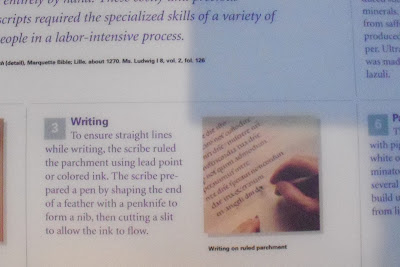At the Getty Center, there was a manuscript exhibit focusing on Medieval Manuscripts called Gothic Grandeur: Manuscript Illumination from 1200-1350. In the exhibit I viewed all 7 steps that the scribes and illuminators take to create the manuscript, including the tools used to make ink and pigments during the Medieval era. The videos and photos below are samples of my visit to the Gothic Grandeur exhibit at the Getty Center:
First Step: The Parchment is prepared
Skin of a slaughtered animal: sheep, calf, goat was sent to the parchment maker.
Second Step: The Ink is prepared.

Fourth Step: Guilding, using Gold Leaf

Skin of a slaughtered animal: sheep, calf, goat was sent to the parchment maker.
Second Step: The Ink is prepared.

The Third Step: Writing the Text --->
To enrue straignt lines while writing, the scribe ruled the parchment using lead point or colored ink. The scribe prepared a pen by chaping the end of a feather with a penknife to form a gib, then cutting a slit to allow the ink to flow (Getty).
Fourth Step: Guilding, using Gold Leaf

Fifth Step: Pigments --->
Pigments were made from plants, chemically produced substances and crushed minerals. Yellow was made from saffron, and green was produced from corroded copper. Ultramarine, a deep blue, was made from ground lapis lazuli (Getty).
Sixth Step: Painting
Seventh Step: Binding
Parchment
The Ellesmere Manuscript is written on 232 vellum leaves (calfskin parchment). The writing space is 12 3/3 by 6 1/8 inches, with ruling lines of light-reddish ink in single columns for 48 lines of text. Four rule-lined flyleaves are placed at the beginning and end of the volume. On the vellum leaf there is a horizontal crease about 4 1/2 inches from the bottom edge. This crease was made in the vellum before the writing and decoration were added. This suggests that the skins of the vellum were prepared by the medieval parchmentor for use by the scribe
Ink and PigmentsPigment can be defined as the coloring agent in paint, and during the Middle Ages scribes of illuminators ground and prepared their own pigments, with the help of an assistant, who helped to purchase their ingredients from an apothecary (1994, Brown).
In the disbinding of the Ellesmere manuscripts, in 1994, Cains defines the accurate pigments used on the manuscript:
Text ink: transparent organic brown in a clear medium, with no crystalline or particlate matter present. The ruling: is a transparent medium stained pink by an organic (crimson) red; fine amorphous clumps of the red pigment are irrgulary dispersed in the medium.
Decoration:
- The blue pigment is ultramarine--either as a pure pigment or mixed with an inert white to give lighter shade.
- The orange-red pigment is red lead. It had darkened when overpainted onto the ultramarine and oxidizxed in some areas to a brown color--a typical characteristic of the aging of lead-containing pigments.
- The white pigment is a transparent white, suggesting that it chalk rather than lead white.
- Carbon Black
- Brown-black asphaltum
- Transparent amorphous green: green particles with a transparent medium, Cains believe may be copper.
- Transparant crimson red-- an organic color from madder, kermes, or orchil
- Pink-- wa s created by mixing red lead, ultramarie and inert white
- Ruling Ink--may use the same crimson red color for the text
- Transparent amorphous purple red: folium or tunsole
- Gold leaf, the guilder's (person who applies gold or silver to a surface) decorations look neat and professional
Pilgrim Portraits Pigments
Various mixtures of pigments were used for the pilgrim portraits:
Amorphous red
Bitumous black and transparent red-brown
Opaque yellow
Some figures have point of goal leaf flaked applied to the parchment, perhaps In these illustrations the gold was used as ink.
Between the design of the pilgrims and the decorations, there seems to be different skill levels, a team of people, perhaps scribes, who contributed to the manuscript. There seems to be a illuminator, and illustrator, and a guilder who worked on the illustrations of the manuscript. There is a School of Illumination which is a group of artist who decorate the same manuscript (1994, Brown). These artist illuminate the manuscript by using luminous colors to enlighten readers.
The illuminator is an artist who mixes and uses colors
The scribe writes the text
The guilder decorates the manuscript with gold or silver ink, or powder (1994, Brown). The guilder must be extremely skilled in his craft because his work is the most detailed. The guilder's part takes more crafting because he is decorating on top of the illustrators work.
Comparing the pigments suggests that the illustrators are less technical than the decorator and guilder.
References
Brown, P., Michelle. Understanding Illuminated Manuscripts: A Guide to Technical Terms. The J. Paul Getty Museum, 1994.
Gothic Grander Exhibit at J.Paul Getty Museum
Gothic Grander Exhibit at J.Paul Getty Museum









No comments:
Post a Comment